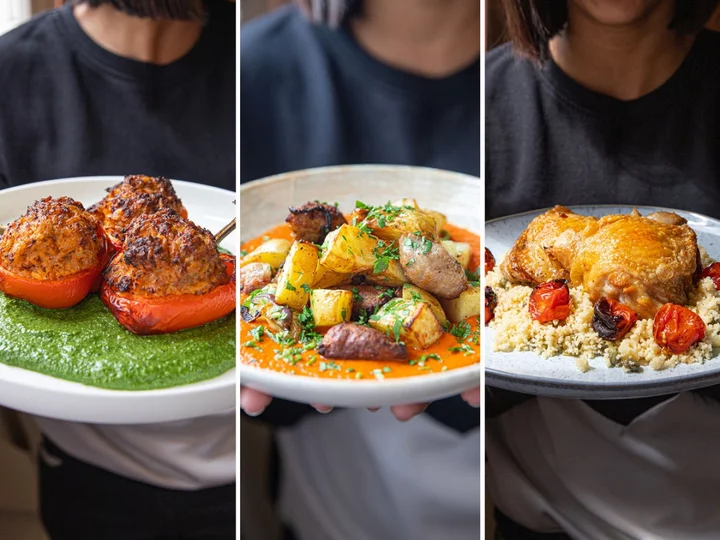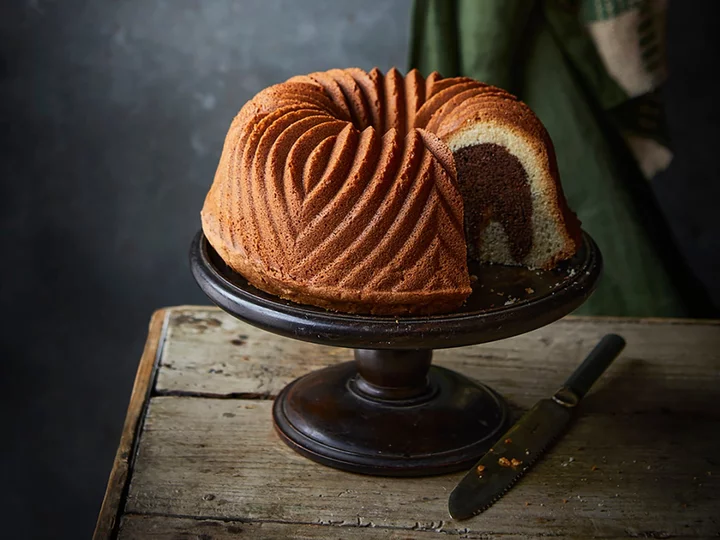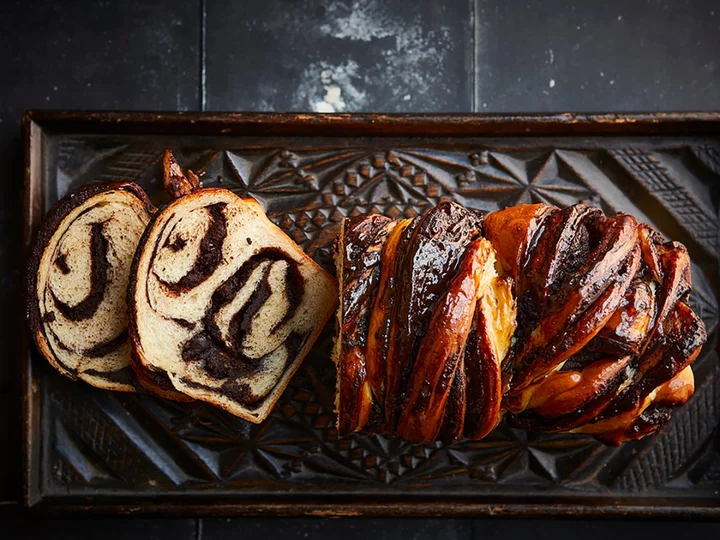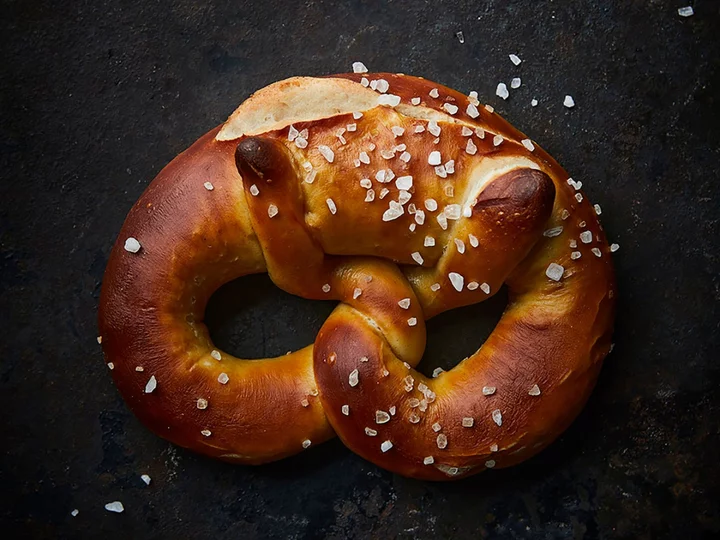
Man who lengthened his limbs by three inches feels ‘so much happier’
A Canadian man has had limb-lengthening surgery, costing £25,000, to increase his height from 5ft 7in to 5ft 10in as he was so insecure about his height it caused him to have “suicidal thoughts”, and claims he is now “so much happier” and “confident”. Daniel Farbod, 27, a civil engineer, from Toronto, Canada, has been self-conscious of his height “all (his) life” – when he stopped growing, at age 14, he said it felt “tragic” and like his “first stab to the heart.” Daniel always defined “being masculine” as being tall, and was “ashamed” of himself as he “didn’t feel like a man.” Over time, being taller was all Daniel could dream about, and claimed his height “impacted his mental health so badly” that he was having “suicidal thoughts”. After coming across the unique surgery online, he realised he was “willing to sacrifice time and money to get (his) life back.” So, in May 2021, he had his first procedure in a specialist clinic in Turkey, which involved breaking his femurs, hollowing out the bone, and putting a rod inside the bone with external fixators, pieces of steel on the outside of his legs. Daniel had to turn the fixators with an Allen key every day for over four months, and eventually had his second surgery to remove the fixators after his bones had successfully fused together. When Daniel recovered, he could not “put into words how happy (he) was” and “felt so much more confident”, now, he is sharing his journey on social media to inspire others who are insecure about their height. Daniel told PA Real Life: “I’m really proud of myself for having the surgery. “I was insecure all my life about my height, it impacted my mental health so badly. “I was suicidal, and after admitting that I wanted to take the steps to feel better, and have the surgery, I feel so much better. “I think for other people, it is important to know how tough the surgery and recovery is – it was the hardest thing I’ve ever done, but for me, it changed my life and made me grow not only literally but also metaphorically as a person.” Daniel, who has always been self-conscious about his height, stopped growing at age 14, and became obsessed with finding ways to become taller. He said: “I researched everything from socks and supplements that claimed to increase your height. “I was always insecure and worried about it – I used to go to orthopaedic doctors because I was so scared of not growing. “But when I got to age 14, I stopped and it was so depressing.” When it became clear to Daniel that he was unlikely to grow any more, it took a toll on his mental health and confidence. He explained: “It was so tragic for me, it was like my first stab to the heart. “All my dreams would be about being taller and I had to somehow accept that my height had peaked. “I tried to keep myself busy to manage my thoughts but in 2020 I just couldn’t handle it – I had all of these negative thoughts and suicidal thoughts because I think being masculine, and being a man, means to be tall. “I didn’t feel like a man, I was so ashamed.” Daniel felt as though having limb-lengthening surgery was the only way he was going to feel better, but his parents, who are both “on the shorter side”, did not approve of his decision to have cosmetic surgery. He said: “Everyone was really against the idea because they thought it was not natural and it was changing the way your body is meant to be. “I knew the surgery was going to be tough, but I thought even that pain would be better than having suicidal thoughts. “I was willing to sacrifice time and money to get my life back.” In May 2021, Daniel had his first surgery in a specialist clinic, Live Life Taller, in Turkey, which involved breaking both of his femurs, hollowing out the bone, and putting a rod inside the bone with external fixators – pieces of steel on the outside of his legs. He explained: “I was really scared when I got to the clinic, and the breaking of the bones was the part I was most nervous about in the whole process. “It was crazy to wake up after the surgery – the reality just hit me all at once and I was so happy.” His recovery involved being in a wheelchair and using an Allen key to turn a bolt on the fixators four times a day at 90 degrees to separate the bone segments a little at a time. Daniel continued to do this every day for four and a half months, saying of his painful recovery: “My skin was stretching, my muscles were growing, it was madness. “It took me even longer to recover, they usually say it will take three months, but, my I had nerve issues with my right leg and had to have it broken again. “It was a very tough time.” In September 2021, the external fixators were removed, he explained: “I used a walker and really really slowly I worked up to using crutches. “I couldn’t really tell how tall I was at that point. “It took me at least another three months to be able to stand up.” Mr Farbod went from 5 ft 7 to 5ft 10 and thinks his mental health has dramatically improved as a result. He said: “I couldn’t believe it. I had been dreaming of being a tall man since I was 10 years old, it’s all I’ve ever wanted. “I went through all these sleepless nights, trauma and upset, and I finally achieved my goal. “I can’t even put into words how happy I was, and still am – I felt so much more confident.” When Mr Farbod arrived home, his family were also very happy for him. He said: “They looked after me so much – I could barely get out of bed or bend down for a long time. “They could tell I was so much happier when I recovered.” Now, Daniel shares his journey on Instagram and YouTube to inspire others who are insecure about their height. He said: “I want to show people the reality of the surgery – it’s tough but I want to raise awareness and get men talking about their insecurities.” For support, contact the Samaritans on 116 123, email them at jo@samaritans.org, or visit samaritans.org to find your nearest branch. Read More Charity boss speaks out over ‘traumatic’ encounter with royal aide Ukraine war’s heaviest fight rages in east - follow live 10 slick ways to kit out your student digs 4 essential officecore trends to update your work wardrobe Sickle Cell Awareness Month: What is sickle cell disease and how do you know if you have it?
2023-08-31 16:48

Sickle Cell Awareness Month: What is sickle cell disease and how do you know if you have it?
Almost 300 babies are born in the UK with sickle cells every year, according to the Sickle Cell Society, and the effects of sickle cell disease are believed to impact thousands. Yet, many people may not even know what sickle cells are or what living with the condition means. What is sickle cell disease? In most people, red blood cells are disc shaped and move easily through the blood vessels. But if you have sickle cell disease, your red blood cells are shaped like a sickle (similar to a crescent moon). This stops them moving with ease through the body and blood flow becomes restricted. Sickle cell disease isn’t actually one specific disease – it refers to a group of conditions affecting people with sickle cells, which range in severity.The conditions are inherited and predominantly affect people from African and Caribbean family backgrounds. What are the symptoms of sickle cell disease? Symptoms begin early in childhood and can sometimes be debilitating. How each individual is affected may vary, but the main symptoms are anaemia, an increased risk of infections, and pain. This includes extremely painful episodes called ‘sickle cell crisis’, which happens when blood flow to certain parts of the body become blocked. According to the NHS, these episodes can last for days and require hospitalisation. Other issues are associated with the condition too, including problems with the lungs, delayed growth in childhood, higher risk of stroke, leg ulcers and sight/vision problems.How is it diagnosed? Sickle cell disease is usually picked up during pregnancy or shortly after birth, although a blood test can be given at any time to see if someone has the condition or carries sickle cell genes. In parts of the country, pregnant people will be offered a test to see what the chances are of their child having sickle cells. Infants can be checked for the cells through a heel prick test.How do you treat it? Treating sickle cell disease is usually a lifelong process to help people with pain and to stay as healthy as possible. Treatment takes place in specific sickle cell centres and those living with it are encouraged to take care of their health, no matter the severity of their symptoms. Managing pain is a huge part of treating sickle cell disease. Staying hydrated can be helpful, as well as avoiding sudden temperature changes, like getting into a cold shower or diving into water. According to the NHS, Hydroxycarbamide (hydroxyurea) may be recommended, which is taken as a pill once a day. This can lower the quantity of other blood cells and requires careful monitoring, however. Some people may also be able to have a medicine called crizanlizumab, either on its own or alongside hydroxycarbamide, usually injected into a vein every four weeks. To prevent infections, many people with sickle cell disease will take daily antibiotics. Read More Charity boss speaks out over ‘traumatic’ encounter with royal aide Ukraine war’s heaviest fight rages in east - follow live TikTok has gone wild for adult gymnastics – here’s what you should know Man explains why he swapped veganism for raw meat diet: ‘I feel great’ Rugby star Ugo Monye: Boarding school shaped my career and my personality
2023-08-31 14:49

Still not sold on air fryers? Let these recipes prove their worth
We’re all sick of hearing about them by now, but air fryers are still enjoying “a moment”. They can also really help reduce the time and energy it takes to make a dish, so we’ve teamed up with the culinary geniuses at Sorted and used this piece of magical kit to cook up three dishes that use it in three different ways. From deeply savoury cheesy sausage-stuffed peppers with vibrant spinach pesto, to hearty and comforting potato and sausage hash with a smoky tomato sauce, these recipes not only showcase the versatility and convenience of air fryers, they’re also pretty damn delicious. Not to forget the crispy chicken thighs and tomatoes with lemon, caper and almond couscous, which demonstrates the art of achieving both crispiness and succulence without the oil. Go forth and revolutionise. Cheesy sausage-stuffed peppers with spinach pesto We use red peppers in this recipe, but if you can’t find them, use any colour of bell pepper to your liking. Serves: 2 Ingredients: 3 red bell peppers 4 tbsp olive oil 250g microwave brown rice 120g cream cheese 1 tbsp tomato purée/tomato paste 4 pork sausages 100g cheddar 200g fresh spinach 30g almond flakes 1 clove garlic 15g fresh parsley 1 lemon Method: 1. Preheat the air fryer: preheat the air fryer to 200C. 2. Prep the peppers: cut 3 bell peppers in half lengthways and scoop out all the seeds from their centres. Rub the peppers with 4 tbsp of olive oil on the board and season with salt. 3. Assemble the filling: crumble 250g of cooked brown rice into a large mixing bowl. Add 120g of cream cheese and 1 tbsp of tomato paste, then coarsely grate in 25g of the cheddar - we will use the rest later. Squeeze in the meat from the casings of 4 sausages. 4. Mix it up: season with salt and pepper, then fold everything together, ensuring the sausage meat breaks up and is well dispersed through the mix. 5. Fill the peppers: divide the mix between the oiled pepper cups - there is no need to press and compact the mixture into the peppers. 6. Fry: pop the pepper halves in the draw of the air fryer, filling side up, and cook for 17-20 minutes until golden in places and piping hot throughout. When cut into, the sausage shouldn’t be pink. Get on with the rest of the dish in the next steps while you wait. 7. Get the spinach ready: add 200g of spinach to another mixing bowl and cover with cling film. 8. Cook the spinach: microwave on full power for 3-4 minutes, until darkened and wilted. 9. Assemble the pesto: once the spinach is ready, add 30g of almond flakes, 1 peeled garlic clove and 15g of parsley to the bowl. Coarsely grate in the remaining 75g of cheddar, then finely grate in the zest from 1 lemon, and squeeze in its juice. 10. Blend it up: blitz everything together with a hand blender, until smooth. Season to taste with salt and pepper. If you are still waiting for the peppers, now would be a great time to crack on with a bit of washing up. 11. Serve: divide the pesto between plates and spread it out to form discs. Top with 3 pepper halves per portion and tuck in. Potato and sausage hash with smoky tomato sauce This recipe can be vegetarian-ised by using veggie sausages instead! Serves: 2 Ingredients: 600g loose white potatoes 1 red onion 4 pork sausages 4 tbsp olive oil 4 cloves garlic 1 tbsp smoked paprika 400g tinned chopped tomatoes 15g fresh parsley 45g cream cheese Method: 1. Preheat: preheat the air fryer to 200C. 2. Prep the potatoes and onions: Cut 600g of potatoes into bite-sized chunks, then halve, peel and roughly slice 1 red onion. Add the veg to a large mixing bowl. 3. Add the sausage: squeeze the meat from the casings of 4 sausages into the bowl, creating little meatballs as you pinch them off. 4. Oil and toss: toss everything with 2 tbsp of the oil and a generous pinch of salt. Remember to wash your hands after handling raw meat. 5. Fry: tip the oiled potatoes, onions, and sausage balls in the draw of the air fryer and cook for 20-25 minutes, until golden in places and the potatoes are soft throughout. Give everything a toss halfway through cooking to ensure an even colouring. Get on with the rest of the dish in the next steps while you wait. 6. Prep the garlic: peel and mince 4 cloves of garlic. Add them to a medium saucepan along with the remaining 2 tbsp of olive oil. 7. Fry: place the pan over a medium heat and slowly fry for 2-3 minutes, until the garlic starts to colour. 8. Add the paprika: add 1 tbsp of smoked paprika and fry for a further 20-30 seconds, until very fragrant. 9. Add the tomatoes: add 1 400g tin of chopped tomatoes to the pan along with a generous pinch of salt. 10. Simmer down: simmer for 6-8 minutes, until reduced by S. Get on with the rest of the dish in the next steps while you wait. 11. Chop the parsley: finely chop 15g of parsley, then crack on with a bit of washing up while you wait for the sauce. 12. Blend: once the tomatoes have reduced by S, add 45g of cream cheese and blitz until smooth with a hand blender. 13. Serve: divide the sauce between plates and top with the fried potato, onion, and sausage. Scatter over the chopped parsley and serve. Air fryer crispy chicken thighs and tomatoes with lemon, caper and almond couscous If you aren’t into capers, you can leave them out or replace them with green olives. Serves: 2 Ingredients: 4 chicken thighs, bone-in, skin-on 200g cherry tomatoes 3 tbsp olive oil 150g couscous 2 tbsp capers 20g almond flakes 1 lemon Method: 1. Preheat: preheat the air fryer to 200C. Fill the kettle with water and put it on to boil - this will be for the couscous later. 2. Oil and season: add 4 chicken thighs to a large mixing bowl along with 200g of tomatoes. Toss with 2 tbsp of the olive oil and a generous pinch of salt, ensure everything is fully coated. 3. Get ready to cook: add the tomatoes and chicken to the tray of the air fryer. Ensure the chicken thighs are positioned on top of the tomatoes, skin-side up. 4. Cook: cook for 20-25 minutes, until the chicken’s skin is crispy and the tomatoes are soft and jammy. Get on with the rest of the dish in the next steps while you wait. 5. Assemble the couscous: add 100g of couscous, 2 tbsp of capers, 15g of the almond flakes, the remaining 1 tbsp of oil and a generous pinch of salt to another large mixing bowl. 6. Add the water: add enough boiling water from the kettle to just cover the grains, then give everything a quick stir. 7. Cook the couscous: set aside to cook the couscous for 6-8 minutes, until the grains are soft and have absorbed all the water. Crack on with a bit of washing up while you wait. 8. Finish the couscous: once the couscous is ready, finely grate over the zest from 1 lemon and squeeze in its juice. Fluff the grains with a fork and fold everything together. 9. Serve: divide the couscous between plates and top with the tomatoes and chicken. Scatter over the remaining 5g of almond flakes and serve. Find out more about Sorted and their nifty meal-planning app Sidekick at sortedfood.com/sidekick. Read More The dish that defines me: Evelin Eros’s rum cake ‘It started with a radish’: Chef Simon Rogan reflects on restaurant L’Enclume at 20 The true story – and murky history – of Portuguese piri piri oil ‘My depression stopped me doing what I loved most in life – cooking’ What Bake Off’s Jurgen Krauss really thinks of his shock elimination How to pull off a traditional German babka chocolate braid
2023-08-31 13:45

TikTok has gone wild for adult gymnastics – here’s what you should know
Have you always wanted to be able to do the splits or a backflip? Maybe you’ve watched your kids do a gymnastics class and thought, ‘Wow, that looks so fun’. Adult gymnastics is gaining some serious popularity online, with the TikTok hashtag #adultgymnastics getting over 209.5 million views. Influencers such as Anna Archer – who has over 300,000 followers on Instagram and creates content surrounding lots of different fitness experiments – and stunt woman Corinne Nicewick have shared clips of their experiences of trying out gymnastics as an adult. Nicewick, despite being a talented stuntwoman, has shared clips of how challenging she has found the sport, with viewers finding her attempts both funny and encouraging. Gymnastics has put some famous faces in good stead for other fitness-related challenges, with gymnast Beth Tweddle winning the 2103 series of Dancing on Ice and Ellie Downie, GB gymnast taking on the gruelling SAS: Who Dares Wins reality show in 2023.So, what do you need to know before you get involved? How does adult gymnastics work? Can anyone do it? Classes have been steadily cropping up across the UK encouraging adults of all abilities to get involved in gymnastics, and unless you have a health problem or injury that may restrict you from doing so, anyone can get involved. It is not so dissimilar to exercises you may already do like plyometrics (explosive body weight resistance exercises like box jumps), CrossFit or yoga. “Gymnastics is a series of different exercises that test your strength, mobility, flexibility and agility,” says Sofia Zolobova, instructor and gymnastics expert at Gymbox. “It’s also a lot of fun, incorporating lots of different floor, beam and hoop exercises,” she explains. This element of variety can bring a more fun, playful element to your workout routine. What are the health and wellbeing benefits of adult gymnastics? Gymnastics will give your body a really different workout and improve your strength, mobility and balance. “Strength and mobility are both very important as we grow older,” says Zolobova. “Gymnastics uses your own body weight, so not only do you get stronger, you move better. For example, to be able to execute a hand stand you need great shoulder mobility,” she explains. “With our modern tight shoulders, gymnastics can be helpful in improving our posture.” How do you get past being scared? As a kid, doing a cartwheel and taking a tumble doesn’t seem so threatening, but as adults we are all a bit more scared of getting hurt. Instead of falling into the trap of fear, embrace the playfulness of it. Zolobova says: “It’s a really fun way to exercise. It includes handstands, cartwheels and frog jumps, letting you unleash your inner child. It empowers you to do cool tricks as an adult and work up to a certain goal. It’s also a great fear fighter – sometimes you just have to let go and trust yourself.” What should we be careful of in adult gymnastics? Your fitness and flexibility may not progress as quickly as they might have done as a child. “Children are naturally more flexible than adults, so when undertaking gymnastics for the first time keep this in mind. Take things slow and one step at a time – you can always build up strength and flexibility with consistent practice,” explains Zolobova. How do we protect our backs and joints? Putting your back out or hurting your joints is a very real fear as an adult. Zolobova says: “Stretching should never be skimped on and should be thorough and dynamic [involving movement]. It’s also very important to make sure the body is warmed up before undertaking any gymnastic moves, a light jog and jumping jacks are great ways to get the muscles warm fast.”
2023-08-30 21:56

Man explains why he swapped veganism for raw meat diet: ‘I feel great’
A 20-year-old has swapped veganism for raw meat, eating uncooked items including beef, chicken, heart and liver on a daily basis for the past four years, and claims he has “never gotten sick”. Jones Hussain, from Stockholm, Sweden, has eaten raw chicken as well as raw cuts of beef, minced meat and fish, without batting an eyelid – even if they are brown or smell slightly. He says he would happily eat any kind of meat provided it is good quality, from “wild boar to camel” but that he prefers minced beef because it is cheap, accessible and does not smell compared with chicken. Jones took the decision to eat raw meat just a few months after quitting veganism in 2019 “in the name of health” after he watched a YouTube video with the late American alternative food nutritionist, Aajonus Vonderplanitz, whose “Primal Diet” has inspired people worldwide. Health has always been important for Jones, who supplements his raw meat diet with fruit and juiced vegetables. He said he would not eat cake for £10,000 because of the sugar and claims to have not had a slice since the age of 13. “If any food safety expert looked at the food I eat, I think they would have a heart attack because the beef is sometimes brown, the liver looks green, the chicken stinks,” Jones told PA Real Life. “But I eat that and then nothing happens. “I did the experiments on myself to see whether what we have been led to believe is actually true and surprise, surprise, it wasn’t.” Jones, who said he has always been driven by “health”, came across the raw meat diet plan in 2019 a few months after quitting veganism. “My starting point has always been health,” he said. “So I’ve experimented with a bunch of things in the name of health.” The diet was designed by Vonderplanitz, who touted the benefits of eating raw foods, in particular meat and dairy. “I found one of his lectures on YouTube and started listening,” he said. “At first, I was just as shocked as anyone would be to see someone eat such a diet.” But Jones said he found Vonderplanitz’s arguments to be “honest and convincing” and so decided to give it a try. “I ate raw meat for the first time in November 2019 and I felt great,” he said. “It was just a straight cut of raw beef.” Having not fallen ill, Jones then decided to try raw ground beef. “That was the scary part because that’s when you enter into uncharted territory,” he said. “I was like, if I get sick then I won’t do this anymore. “Lo and behold, again, I didn’t get sick, so I started eating raw ground beef because it’s much cheaper than straight cuts.” To start with, Jones would flavour the raw meat with spices and garlic. “But then I felt that I didn’t need them, even from a taste perspective,” he said. “So I just started consuming it by itself and ever since then I’ve eaten raw ground beef almost every day.” By the summer of 2020, Jones had become accustomed to eating all types of meat. “I had no problems eating raw chicken because I had found a fairly good source in the supermarket so I ate it like KFC,” he said. “I also started buying raw liver here and there, and eating a small amount every day.” The raw meat Jones kept in his fridge soon started to turn “green”, but this did not stop him from eating it. “Since I was so convinced about what Aajonus was saying, I was not worried and just consumed it,” he said. “But if there was any white mould, then I got rid of the batch, although this did not happen very often.” Jones has continued eating raw meat ever since, although his family prefers ground beef to chicken because of the smell. “Nowadays I don’t so much eat raw chicken because it stinks up the house,” he said. In a single sitting, Jones said he is capable of consuming around 400g of raw liver. He said he believes dumping veganism for raw meat has improved his gut health and helped get rid of his acne. “The thing with raw meat is that the nutrients are more easily absorbed and unaltered,” he claimed. “It’s not that raw meat has some kind of special super power, it’s just that by not cooking it, I get more nutrients and no byproducts.” NHS guidelines, however, state that “cooking meat properly” kills harmful bacteria which can cause food poisoning. Jones had been a vegan for two years, from 2017 to 2019, before eventually converting to the primal diet. “It’s not that I was struggling to get enough nutrients,” he said. “It’s that a human being cannot survive on a vegan diet successfully. “Of course you can take supplements but it’s not the same thing, because they are processed. “There is no other way of getting these nutrients naturally other than by eating animal products. “So veganism on that basis, falls on its face.” Jones also eats raw fish such as salmon and tuna and said he is happy to eat any type of meat provided he can find a reliable supplier. The Primal Diet also includes fruit and vegetables, all of which are consumed raw. “I eat cucumbers and tomatoes, as well as oranges and apples when they are available to me,” he said. “The philosophy is don’t cook the food, but there is a variety.” Jones’ unusual diet often shocks people, including his parents who are concerned for his wellbeing. He explained: “Usually people have the same reaction, at first they think what the hell is this guy doing? He’s going to die in a few days. “Then they speak to me and find out that I’ve been doing it for three and half years, that I’ve never gotten sick, that my arguments are logical and that I look healthy. “They are like all right, that’s a new perspective that I had not heard before.” People behave differently on social media, however, said Jones, who has his own YouTube channel, Excellent Health. He also works part time at an elderly day care centre and has written a book titled The 6 Health Commandments. “The only time I ever got food poisoning was from a frozen bag of raspberries before I started eating meat,” he said. “I decided not to act out of fear, but to see what is true and what isn’t true.” To find out more about food safety, visit www.food.gov.uk/safety-hygiene/cooking-your-food. Read More Eating a raw vegan diet almost killed me Study reveals one thing to focus on if you want to live to 100 Charity boss speaks out over ‘traumatic’ encounter with royal aide Ukraine war’s heaviest fight rages in east - follow live
2023-08-30 19:24

Rugby star Ugo Monye: Boarding school shaped my career and my personality
The Rugby World Cup and new series of Strictly Come Dancing are both set to kick off soon – and one man who knows just how hard both of them are is Ugo Monye. “Strictly is gruelling,” says the former rugby pro-turned-pundit, who played with Harlequins and England before taking part in Strictly in 2021. “At times you’re training for 12 hours a day. So, you could go for a period of three or four days where all you do is wake up, go to the studio, go to sleep, wake up, go to the studio, go to bed.” He recalls recently telling his friend, comedian Eddie Kadi, all about this, the night before he was announced as a contestant for this year’s show. And because of the demanding schedule, taking care of yourself becomes a top priority. “You try and eat right, try and get as much sleep as possible. The biggest initial challenge everyone will find is their feet, because they wouldn’t have been used to dancing for 11 hours a day,” adds Monye, 40, who was partnered with Oti Mabuse on the show. Trading his rugby boots for ballroom shoes came with some challenges, but he still completed five weeks on the show (Monye and Mabuse finished in 11th place that year). “I remember when I did the quickstep, I had my Apple Watch on, which showed that I danced over 45km in five days,” he recalls. “I remember the first week or two, just the nervousness of rolling out of bed and putting my feet on the carpet because you didn’t know how they would feel.” Having played such a physically demanding sport for 13 years at pro level, Monye was not in bad shape. But Strictly was another “type of pressure”. “When I retired in 2015, I never thought that I’d be dancing, dressed in a low cut, electric pink, short sleeve shirt doing the samba. It’s something I’m actually really proud of,” he adds happily. Like lots of people, Monye, who has two daughters – Phoenix Lilly, six, and Ruby, three, with his ex-wife Lucy – recalls how his approach to self-care has evolved over the years. “Going back to the early 2000s, I was living the dream, right? I was 18 and I got a professional contract playing for my boyhood club, and within a year I travelled the world playing for England,” he says. “I was all, what mental health? I’m flying, right?” Things shifted with time, however, and he began to see the importance of having a proactive approach to maintaining his mental wellbeing. “I remember speaking to a friend, who is really interested in mental health, [about how] people often seek [mental health support] after something bad or traumatic has happened to a point where they actually need it. But it’s more like how you have to go and get an MOT on your car and service it,” he explains. “I think towards the end of my career, I became more aware of it. I have now definitely paid more attention to it and I absolutely love psychology, so I love understanding how the mind works.” Since his retirement, Monye – who has teamed up with Samsung ahead of the World Cup, which starts on September 8 – he has been busy being a dad, alongside jumping into a vibrant broadcast career. Having daughters made him reflect on his own upbringing too – going from being raised by a single mother on a London council estate, to a rural boarding school in Hampshire where he had his education funded (Monye secured a sports scholarship when he was 13). He attributes a lot of his success to his schooling. “I think the person I am now was born at age 13. Everything I was surrounded by was slightly different in that world. It was where I first was introduced to rugby, which then has quite clearly gone on to shape my career, the pathway that I have now, but also my personality. “I think I rely upon myself, I back myself. I had to depend on myself and try and get things done,” he reflects. “I think my personality traits, good and bad, were all developed at boarding school.” Having spent large chunks of his childhood away from family, how does he manage his own work-life balance as a parent now? “How do you manage your work-life balance? Well, you stand in the middle of the park taking a phone call,” he jokes (Monye is in the playground with his girls while we talk). “The time I have with them is absolute quality. For the World Cup, I’m going out for like three or four stints. I’d love them to be able to come out, but with school, it is a bit more difficult. “But I have said to Phoenix already that next year is the Olympics, and she loves gymnastics, so she’s going to be getting on the Eurostar with me. She is watching a lot of clips of Simone Biles at the moment on YouTube and she’s obsessed.” He wants to see his daughters inspired by brilliant women. “I love to watch sports with my daughters,” says Monye. “And we loved watching the Women’s World Cup. I had to get them to come and watch incredible women just do it.” Ugo Monye has teamed up with Samsung ahead of the world’s biggest rugby tournament (samsung.com/uk/big-screen-tv) Read More Charity boss speaks out over ‘traumatic’ encounter with royal aide Ukraine war’s heaviest fight rages in east - follow live Why do we crave brand new clothes and how can we resist the urge to buy them? How can I improve my teenager’s low mood? Drinking alcohol does not make people look more attractive, study suggests
2023-08-30 18:27

Drinking alcohol does not result in ‘beer goggles’ making people look more attractive, study says
When it comes to approaching someone you like at a bar, it may be more a case of alcohol giving you liquid courage than “beer goggles”, researchers say. A new study suggests drinking alcohol makes people more likely to approach someone they already find attractive, but does not make others appear more attractive. Some people argue that intoxication makes others seem better-looking – but according to the researchers, this has not been systematically studied. Past research typically had people simply rate others’ attractiveness while sober and while intoxicated based on photos. But the new study added the possibility of meeting the people being rated. The study, led by Molly Bowdring of the Stanford Prevention Research Centre, Stanford University, in the USA (affiliated with University of Pittsburgh at the time of this study), and her dissertation adviser, Michael Sayette, involved 18 pairs of male friends in their twenties. The men were brought to the laboratory to rate the attractiveness of people they saw in photos and videos. They were also told that they may be given the chance to interact with one of those people in a future experiment. After the ratings were given, the men were asked to pick those who they would most like to interact with. Pairs of men visited the lab on two occasions – on one occasion they both received alcohol to drink – up to about a blood alcohol concentration of .08 per cent, the legal limit for driving in England, Wales and Northern Ireland, and the United States, and on the other occasion, they both received a non-alcoholic drink. Friend pairs entered the lab together in order to mimic social interactions that would typically take place in a real drinking situation. The researchers say they did not find evidence of beer goggles – whether or not the men were intoxicated had no effect on how good-looking they found others. Professor Sayette, from the University of Pittsburgh, said: “The well-known beer goggles effect of alcohol does sometimes appear in the literature, but not as consistently as one might expect.” However, according to the findings, drinking alcohol may affect how people react to those they find attractive in a different way. The researchers found it impacted how likely the men were to want to interact with people they found attractive. When drinking, they were 1.71 times more likely to select one of their top-four attractive candidates to potentially meet in a future study compared with when they were sober. The researchers suggest alcohol may not be altering perception but rather enhancing confidence in interactions, giving the men liquid courage to want to meet those they found the most attractive. According to the researchers, the findings could have implications for therapists and patients. Prof Bowdring said: “People who drink alcohol may benefit by recognising that valued social motivations and intentions change when drinking in ways that may be appealing in the short term, but possibly harmful in the long term.” The findings are published in the Journal of Studies on Alcohol and Drugs. Read More Yewande Biala thought she was unique in never having had an orgasm – then she made a film about it The dish that defines me: Evelin Eros’s rum cake Woman adopts husband’s ex-wife’s son after growing up in foster care herself Charity boss speaks out over ‘traumatic’ encounter with royal aide Ukraine war’s heaviest fight rages in east - follow live
2023-08-30 15:26

How can I improve my teenager’s low mood?
If there’s one thing associated with teenagers more than anything else, it’s moodiness. But although low mood is extremely common in teens, what’s just as common is that parents don’t know what to do about it. Adolescence is the highest risk period of life to experience depression, and half of adult mental health disorders start before the age of 15, says consultant clinical psychologist Dr Beth Mosley, who provides specialist mental health support to children and their families. “Seeing the signs of low mood in your teen can be worrying if you’re a parent,” she says. “The questions you may ask are likely to be, what are the usual highs and lows of adolescence, and what is something to worry about? Why might my teen be struggling with low mood, and most importantly, what can I do as a parent to help if my teen is feeling down and showing signs of disengaging with life?” Mosley, the author of new book, Happy Families, which is about the most common issues affecting children’s mental health and how parents can help, says although everyone will, at some point, experience low mood, sadness, irritability and loss of interest in things they enjoy, usually such feelings are linked to problems in life. But changes associated with puberty, and brain restructuring, mean adolescents are especially vulnerable to mental health problems, says Mosley, who explains: “These changes increase the possible impact of life stressors and, thus, their vulnerability to mental health difficulties. “The brain changes in adolescence mean teens feel emotions more intensely – both the highs and lows – meaning it’s not unusual to see them experiencing waves of low mood, particularly in the face of challenges.” She says if a teen’s low mood doesn’t go away, and prevents them doing the things they need to, like schoolwork and spending time with others, it would be wise to consider seeking help. The teen’s school may be able to suggest local support. But she adds: “Whether your teen experiences passing or more persistent low mood, the good news is that the brain is flexible and ripe for learning in adolescence, so there’s a lot we can do to support our teens when they’re experiencing low mood. “Importantly, this support will likely improve your relationship with your teen, and help protect them from developing mental health difficulties in adulthood.” If your teenager’s mood is low, these are the things Mosley says might help them… Encourage them to do what’s important to them When someone feels low, they tend to do less of what’s important to them, meaning they get less rewards from life and feel lower, Mosley explains. This is the low-mood cycle. Conversely, by doing more of what’s important to them regularly, they get more reward from life and start to feel better – this is the feel-good cycle, she says. So rather than a teen waiting until they feel better to do the things that are important to them, low-mood teens should do them now to break the low-mood cycle. “Determining what activities they can do more of and what unhelpful activities to do less is a key first step,” says Mosley. “You can support your child by providing more opportunities to do what’s important to them and increasing access to rewards. Give them practical support to do the activities they enjoy, provide encouragement.” Communicate better with them Mosley says that low mood can make it difficult for teens to communicate, but parents learning key communication skills can support how they communicate with their teens and, in turn, help improve their mood. She says being careful how you say things, through tone of voice and nonverbal body language, is important, as teens are more sensitive to criticism and negative social feedback. But there are six communication skills in particular that parents should try to use. They are… Picking the right time to have a conversation. “Open and honest conversations are most likely to happen when we’re feeling calm and not under pressure,” says Mosley, explaining that it’s important to be aware of when your teen isn’t in the right frame of mind for a difficult conversation, and to learn to respectfully pause the conversation and reschedule it for a better time. Starting a sentence with ‘I’ rather than ‘You’ can make a huge difference, explains Mosley, who says starting with ‘You’ often has a blaming tone and makes the teenager defensive and stops them from listening, whereas starting with ‘I’ can explain how you’re feeling, which can’t be disputed and starts a whole different conversation. Instead of over-generalising and using words like ‘always’ or ‘never’, Mosley says it’s much better for parents to be specific and provide an example of a recent event, rather than things that have happened over months or years. She says over-generalising is more likely to make teens feel awful, and less likely to spark a collaborative conversation. Imagining how a young person might feel in/about a certain situation can also help, she says. “Understanding someone else’s point of view, and expressing this to them, can make it easier to have a collaborative conversation and avoid an argument,” she explains. “When we’re particularly worried about our children, thinking about how they feel can sometimes help us connect with them.” If you go into a conversation with your child knowing what you want from it but being aware you might not get it, be prepared with some alternative solutions, Mosley advises. “Having a few solutions in your back pocket before you go into a discussion enables you to show you’re willing to compromise so you don’t get stuck in a stalemate situation,” she says. Although you may not initially get the response you hoped for from your child when you try a new way of communicating with them, it’s vital to persevere, stresses Mosley, who explains: “With these communication hacks we should begin to see communication with our children become healthier and more productive.” Tackle your negative thoughts and help your teenager do it too Mosley advises parents to reduce the habit of getting stuck in negative thinking by trying these tactics, which she suggests should be shared and modelled to teens. Remember it’s just a thought and it doesn’t mean it’s real. “Remind your teen that thoughts are not facts, they are ideas and they don’t predict the future,” says Mosley. Let negative thoughts come and go, rather than fixating on them and becoming overwhelmed, she advises, and take the power out of the thought by sharing it with others. “Getting another viewpoint can stop unhelpful thoughts growing in magnitude,” she says, and suggests parents provide opportunities for teens to share their thoughts with them, on car journeys and walks etc. As many young people get stuck on social media, dwelling on distressing thoughts, Mosley suggests: “Help your teen notice this cycle and learn the art of moving to another activity, even if it’s just moving to a different room or doing some physical activity.” She adds: “If your teen is feeling negative and self-critical, move away from nagging and towards helping them refocus their energy on something they enjoy and/or resolving the underlying problem.” Happy Families: How to Protect and Support Your Child’s Mental Health by Dr Beth Mosley is published by Bluebird on August 31, priced £18.99. Read More Charity boss speaks out over ‘traumatic’ encounter with royal aide Ukraine war’s heaviest fight rages in east - follow live Maya Jama and Stormzy: Can you make it work with an ex? 12 smart ways to save money on everyday back-to-school costs 9 ways to make dark rooms look lighter
2023-08-30 15:22

Quick, moist and flavourful: Jurgen Krauss’s marble cake
This cake was a standard on our Sunday coffee table and has a lot of nostalgia for me. It is quick to make, moist and flavourful, and the marble pattern was always fascinating to me as a child,” says former contestant on The Great British Bake Off, Jurgen Krauss. Marble cake Serves: 12-24, depending on tin size. The amounts given are for a loaf tin (950g) or a Bundt tin. For a bigger Bundt tin, double the amounts and bake for 15 minutes longer. Ingredients: For the batter: 125g unsalted butter or margarine, room temperature 2 tsp vanilla extract 2 eggs, separated 180g caster sugar 250g plain flour 8g baking powder 125ml whole milk For the chocolate batter: 10g cocoa powder 15g caster sugar 25ml double cream ¼ tsp ground cloves Method: 1. Preheat the oven to 170C fan/gas mark 5. 2. Put the butter in a bowl and, using a hand mixer or a stand mixer fitted with the balloon whisk, beat the butter until it is light and pale. Add the vanilla extract and egg yolks, alternating with the sugar bit by bit, and whisk for another 15 minutes until the butter and sugar mix is very frothy and white. 3. Sift the flour and baking powder together in a bowl. Alternate adding the flour and milk bit by bit to the batter while whisking on a low speed. 4. In a separate bowl, whisk the egg whites to soft peaks. Fold the egg whites into the butter and flour mixture. 5. For the chocolate batter, take one third of the plain batter and put it into a separate bowl. Fold in the ingredients for the chocolate batter. Put the two batters in a greased 950g Bundt tin or a loaf tin, starting with the vanilla batter, then add a layer of chocolate batter and finish with vanilla batter. Use a fork to create the marble effect by pulling it through the layers of batter with a swirling motion. Bake for about one hour; the cake should start separating from the tin and a skewer inserted into the cake should come out clean. Cover with foil if the top of the cake starts getting too dark. 6. Leave the cake to cool in the tin for at least 20 minutes before attempting to take it out of the tin. 7. This cake keeps very well for up to a week in an airtight container and for the first three days its flavour actually improves. ‘German Baking: Cakes, Tarts, Traybakes And Breads From The Black Forest And Beyond’ by Jurgen Krauss (published by Kyle Books on 31 August, £26). Read More The dish that defines me: Evelin Eros’s rum cake ‘It started with a radish’: Chef Simon Rogan reflects on restaurant L’Enclume at 20 The true story – and murky history – of Portuguese piri piri oil ‘My depression stopped me doing what I loved most in life – cooking’ What Bake Off’s Jurgen Krauss really thinks of his shock elimination How to pull off a traditional German babka chocolate braid
2023-08-30 14:00

How to pull off a traditional German babka chocolate braid
What looks more stunning than the randomly swirling bands of dark chocolate in this loaf of white sweet bread? This style of braiding is known in many countries, and is used with different fillings as well,” says former contestant on The Great British Bake Off, Jurgen Krauss. “Always an eye-catcher, it used to be a special treat on our Saturday afternoon coffee table. The rich spices and citrus zest in combination with chocolate make this truly a great braid for any special occasion.” Babka chocolate braid Serves: 15 Ingredients: For the dough: 190g bread flour 140g white spelt flour or plain flour, plus extra for dusting 6g instant yeast 1 pinch salt 40g caster sugar 180ml whole milk 1 medium egg 40g unsalted butter, softened Zest of 1 lemon Zest of 1 orange ½ tsp ground cardamom For the filling: 100g dark chocolate (54% or 70% cocoa solids, to taste) 60g unsalted butter 60g soft light brown sugar 2 tsp ground cinnamon ½ tsp ground cloves 30g cocoa powder Unsalted butter, melted, or apricot jam for glazing Method: 1. For the dough, put all the ingredients in a bowl and, using your hands or a stand mixer fitted with the dough hook, mix the ingredients until evenly distributed. Then knead the dough for several minutes until it has a smooth and silky texture. Cover with a tea towel or a plastic bag and leave to prove at room temperature for about one hour. Check with the poke test that the dough is ready. 2. Meanwhile, prepare the filling. Put the chocolate, butter and sugar into a pan and melt over low heat. Once liquid, take the pan off the heat and add the cinnamon, cloves and cocoa powder. It’s OK if the filling looks grainy. 3. Line a 950g loaf tin with baking paper. 4. On a lightly floured surface, roll out the dough to a rectangle measuring about 50 x 30cm. Spread the chocolate filling over the dough rectangle, leaving 2cms of the far short edge uncovered. Roll up the dough rectangle, starting at the near short edge. Seal the seam by pinching it. 5. Place the roll on a work surface with the seam facing down and, with a sharp knife, cut the roll lengthwise into halves. Twist the halves together to form a rope. You can do this starting at one end and twist this half of the roll, and then do the same for the other half; this way you don’t have to manipulate the whole length at once. 6. Place your hands palm down on the ends and, with a scooping movement, bring the ends to meet underneath the middle of yourrope. Transfer this into the lined tin, and cover with a tea towel or a plastic bag. Leave to prove for 30 minutes to one hour until the Babka is well risen and the dough starts to feel fragile; a gentle touch with a finger will leave a dent that only slowly recovers. 7. Preheat the oven to 170C fan/gas mark 5. 8. Bake the babka for 30-40 minutes. 9. Melt the butter for glazing or heat the apricot jam with a teaspoon of water. Brush the babka with melted butter or jam as soon as it is out of the oven. Leave to cool for about 15 minutes, then carefully remove from the tin and baking paper. 10. Let the babka cool completely before eating. Stored in an airtight container it will last for three days. ‘German Baking: Cakes, Tarts, Traybakes And Breads From The Black Forest And Beyond’ by Jurgen Krauss (published by Kyle Books on 31 August, £26). Read More The dish that defines me: Evelin Eros’s rum cake ‘It started with a radish’: Chef Simon Rogan reflects on restaurant L’Enclume at 20 The true story – and murky history – of Portuguese piri piri oil ‘My depression stopped me doing what I loved most in life – cooking’ What Bake Off’s Jurgen Krauss really thinks of his shock elimination Quick, moist and flavourful: Jurgen Krauss’s marble cake
2023-08-30 13:49

Knotty and nice: Jurgen Krauss’s homemade soft pretzel recipe
Pretzels, or brezel or brezen in German, are the most iconic German food. Ornaments of pretzels adorn every bakery, and images of them can be found on medieval church windows in Freiburg, where I come from,” says former contestant on The Great British Bake Off, Jurgen Krauss. “Often, a pretzel works better as a soother for an upset baby than a dummy. They are a part of my upbringing and heritage. And still, there is no better snack after a long shopping spree through my hometown of Freiburg than a brezel from the bakery at the tram stop. “Disclaimer about lye: I am giving two options for the finish. One is using lye, which involves a very dangerous chemical, solid sodium hydroxide. The other option uses baking soda, which is bicarbonate of soda, and is not dangerous at all. The results are different in colour and taste, but without a direct comparison, the bicarbonate of soda pretzel can stand its ground. If you intend to use lye, I’d recommend baking a few batches of pretzels with bicarbonate of soda, but treat it as if it was lye, to practise the handling and have everything in the right place before starting.” Soft pretzel Makes: 8-10 Ingredients: For the starter: 100g bread flour 2g salt 1⁄8 tsp instant yeast 65ml water For the dough: 400g bread flour 9g salt 20g honey 5g instant yeast 25g unsalted butter, room temperature 180ml water Coarse salt crystals, for sprinkling For the lye or bicarb dipping solution: 2L water 8g salt 80g bicarbonate of soda or 80g sodium hydroxide pellets Method: 1. Prepare the starter the day before baking. Combine all the ingredients in a bowl and mix with your hand or a spatula until all the flour is incorporated. Cover with clingfilm and leave to stand at room temperature for about two hours. Then put the starter in the fridge overnight until you need it – it will be good to use for up to three days. 2. About one hour before making the main dough, take the starter out of the fridge. 3. To make the main dough, combine all the ingredients except the salt crystals and the starter in a bowl and mix with your hand or a spatula. The resulting dough will be very stiff. Knead the dough on a work surface for about 10 minutes. Don’t use any additional flour, you won’t need it anyway. The resulting dough should be smooth and a bit elastic. Put the dough into a bowl, cover and prove at room temperature for about two hours. Fold the dough once after one hour. 4. Meanwhile, prepare the dipping solution. Use a big stainless-steel pan and stainless-steel spoons for dipping. Cover your normal work surfaces in case the lye spills. When dipping, keep the baking sheets very close to the lye pan and the oven. Always wear protective gloves and goggles when working with sodium hydroxide and lye. Never ever touch sodium hydroxide pellets with your skin. 5. If using bicarbonate of soda, bring the water to boil. Switch off the heat, add the salt and stir. Then add the bicarbonate of soda – there will be a bit of frothing and splashing, so be careful. Leave to cool. 6. If using sodium hydroxide, put the water in the pan and then add the sodium hydroxide pellets. Sodium hydroxide creates a lot of heat when it dissolves. 7. Once the dough has proved, divide it into pieces weighing 85 grams each. Roll each piece of dough into a cylinder. Once all the pieces have been rolled, start again with the first piece, to roll it into a long strand with thin ends and a belly in the middle. Aim for a length of 60 centimetres. Make sure you don’t tear your strands – if there is too much resistance in the dough, move on to the next strand. You will need several cycles to reach the length required. 8. Now shape the pretzels – the bakers use a slinging method, but there is a simpler, slower way to do this. Make sure the ends of the little arms are well attached to the middle bit. 9. Place the pretzels onto lined baking trays, cover and leave to prove at room temperature for about 45 minutes. Uncover the pretzels and put them in the fridge for 30 minutes, so that a skin can form. Preheat the oven to 230C fan/gas mark 9. 10. Take the pretzels out of the fridge. Dip each pretzel in lye or sodium carbonate solution for about five seconds. Transfer the pretzel back onto the lined baking sheet. One sheet will hold four to five pretzels. Once the sheet is full, slash the thickest part of the pretzels with a sharp serrated knife and sprinkle with salt crystals. Transfer to the oven immediately and bake for 12–15 minutes. Leave to cool on a wire rack. Repeat with the remaining pretzels. 11. Because of the salt, these pretzels are best eaten fresh. ‘German Baking: Cakes, Tarts, Traybakes And Breads From The Black Forest And Beyond’ by Jurgen Krauss (published by Kyle Books on 31 August, £26). Read More The dish that defines me: Evelin Eros’s rum cake ‘It started with a radish’: Chef Simon Rogan reflects on restaurant L’Enclume at 20 The true story – and murky history – of Portuguese piri piri oil ‘My depression stopped me doing what I loved most in life – cooking’ What Bake Off’s Jurgen Krauss really thinks of his shock elimination How to pull off a traditional German babka chocolate braid
2023-08-30 13:47

What Bake Off’s Jurgen Krauss really thinks of his shock elimination
Jurgen Krauss’s elimination from the 2021 Great British Bake Off caused such a scandal, Ofcom received 115 viewer complaints. The lovable German baker was seen as a top competitor, winning three star baker prizes before being booted off in the semi-finals. Nearly two years on, Brighton-based Krauss, 58, has no hard feelings – but he did see the uproar coming. “I had a feeling there would be complaints – a feeling that people would take it very seriously,” he says. But he still has only good things to say about the show, noting the “overwhelmingly positive reaction was quite amazing”, and crediting the experience with boosting his baking skills massively. He speaks particularly fondly about the period before the competition started, when the contestants were in a bubble and testing their recipes. “We had nine weeks to prepare one signature and one showstopper each week and submit the recipe – that was really a huge time for growth,” he says. He calls this a period of “non-stop new ideas, non-stop new processes”, adding with a wry laugh: “Most of the things I’d done in the tent I’d never done before, and some of them I’ve never done since, [and] I’m not sure I’ll ever do them again. It was tough – it was amazing.” Many of the bakes Krauss made on the show were inspired by his childhood in the Black Forest, Germany. This formed the start of his new cookbook, aptly called German Baking: Cakes, Tarts, Traybakes And Breads From The Black Forest And Beyond. “During Bake Off, the briefs of all these signature bakes often included references to childhood that really reconnected me to my culinary home, to the Black Forest and the cooking of my parents, the things I liked to eat as a child or teenager, or while I was studying.” Some of Krauss’ favourite food memories growing up are from the period before Christmas. “My brother and I, we were always in the kitchen with my mother, we were always part of cooking and baking Christmas – the time before Christmas was always amazing,” he remembers. “It was fun, getting hands sticky in dough and tasting it all, and using ingredients like kirsch [brandy made from cherries]. I didn’t think much of it, being able to make cakes like cheesecakes or Linzer torter [a spiced tart that would kick off the Christmas period in Krauss’ household]. “But then much later, after the move to England [in 2003], I really took a deep dive into making bread. After 10 years or so, I really was craving German bread.” From apple marzipan tarts to the classic Black Forest gateau, Krauss’ book is an ode to his childhood and where he grew up. “Black Forest is an interesting region, because it has influences from France and Austria,” Krauss explains. “It had a varied history. It was Austrian for almost 200 years – you get dark breads, but rye isn’t such a dominant grain as it is in other German areas. That’s the Austrian influence – you get a lot more wheat and you get things like pancakes and dumplings, more than in other German areas, which is clearly inspired by the Austrian kitchen. “You have also a huge influence from France and Alsace in terms of day-to-day cooking, so it’s a bit of a conglomerate.” Despite its name, Krauss suggests the Black Forest gateau was actually invented in Dortmund – a city around five hours’ drive away from his home. “But it has become iconic because on the borders of the Black Forest in the Rhine Valley there are huge orchards and cherries grow very well there. Making kirsch has a long tradition, making fruit brandies has a long tradition in the Black Forest because of that.” Other recipes in the book include the Flammkuchen, or what Krauss describes as “kind of a Black Forest pizza”. “It’s an unleavened bread, so you could say it’s a matzah with sour cream on it, and you can put lardons on it, onions, or you can make it sweet with cinnamon sugar and apple slices. It’s really so easy – you can have it ready in 20 minutes, from start to finish. You just need to have an oven that goes really hot.” While the book is all about traditional German baking, Krauss has added the occasional modern twist. He says animal products are prominent in German cooking, “And they don’t run very strongly through my bakes in the book, because I wanted to make it appealing to a very wide audience. So I didn’t use lard, where a traditional Black Forest baker would probably use lard or lardons – things like that. I definitely scaled back on that. You would make dumplings or doughnuts in lard, you would fry them in lard – this sort of thing has lost its appeal over the last few years I think.” While he’s still known to many as “Jurgen from Bake Off”, Krauss says he’s come a long way since the show. “I feel much more in command of things,” he muses. “It feels a lot easier for me to change things. I got to a stage in bread baking where I can go fancy and know the outcome will be OK. I never had that with sweet things before Bake Off. “But now I can see how to change ingredients and how recipes work in general – so that’s a huge change.” ‘German Baking: Cakes, Tarts, Traybakes And Breads From The Black Forest And Beyond’ by Jurgen Krauss (published by Kyle Books on 31 August, £26). Read More How to save money in the kitchen according to top chefs The chef who hated food as a child Discovering Sierra Leonean flavours in South London The dish that defines me: Evelin Eros’s rum cake ‘It started with a radish’: Chef Simon Rogan reflects on restaurant L’Enclume at 20 The true story – and murky history – of Portuguese piri piri oil
2023-08-30 13:45
